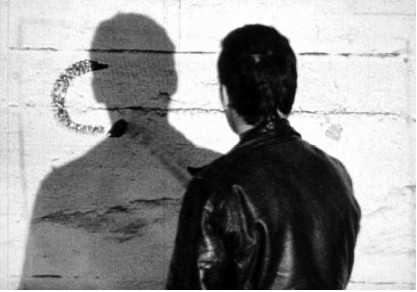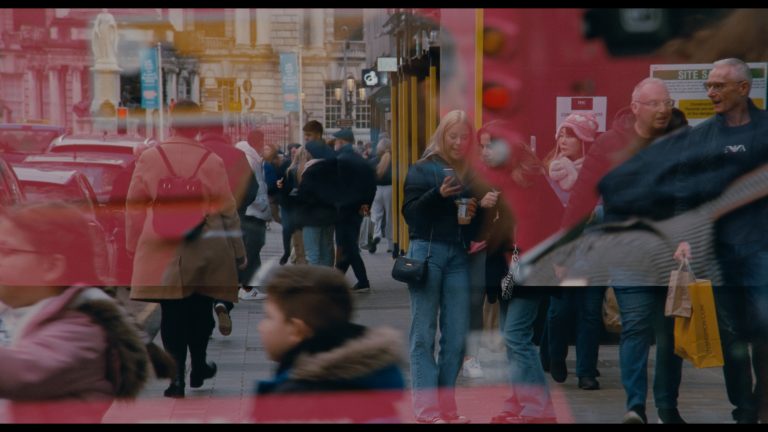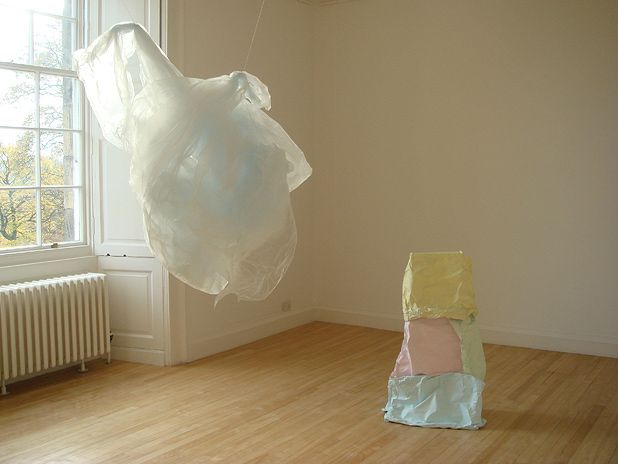Sit back, relax and enjoy the movie – even if it is a more obscure strand of 1960’s avant-garde German cinema than one is generally accustomed to. This is the premise behind Auto-Kino!, a drive-in cinema showing a variety of experimental film accompanied by the usual movie stalwarts of popcorn, soft drinks and comfortable chairs. Dreamt up by British artist Phil Collins and installed in Berlin’s Temporäre Kunsthalle. Auto-Kino! brings a lively, upstart energy to Berlin’s stately Schlossplatz.
An array of 1980’s Audis, boxy Mercedes and beaten-up VW Golfs greeted us as we entered the cinema. All were bathed in seedy red light recalling those early characterisations of the drive-ins as “passion pits.” We sought our car, differentiated from the others by number plate. Something about the setting made us feel like we had never been in a car before, or at least not in circumstances like this. Our fellow movie-goers clutched brown paper bags containing beer, while others investigated the options in the vending machine. As we eased into our outmoded BMW, adjusting the antiquated seats, the screen kicked into life. We soon realised that the audio was intended to be broadcast through the radio, from which only a low hum could be heard. We spent some time fiddling with the frequency but a quick glance in the rearview mirror confirmed that the radios in the others cars were also kaput.
Not that sound would necessarily have helped to make much more sense of Werner Schröter’s Neurasia, which was screened during my visit. Dating from 1968, this black-and-white film comprises of a series of bizarre scenes from a world seemingly unbound by social convention. A small group of male and female actors dance, play music and interact on a small stage in varying states of undress but with an unchanging intensity of expression. On further reflection, it appeared to be a heightened exploration of life’s most dramatic themes: love, sex, death and betrayal through deliberately theatrical gestures which, while producing a number of striking motifs, verged too much on melodrama for my taste. Unfortunately, any merit bestowed by the singing and dancing was lost due to the lack of sound.
In the light of the rest of the Auto-Kino! programme, Neurasia serves to demonstrate the experimental capacities of film and its dramatic potential as a medium. This inquiry into modes of representation is one of Collins’ chief artistic, as well as curatorial concerns. His films, events and installations often explore the power of the media by appropriating elements of pop culture and, as in Auto-Kino!, immediately connect with the viewer through such popular formats. While this is humorous, it is also compelling and engages us with Collins’ concerns. In this case, he entices us to watch experimental film in the comfortable and relaxing environs of the drive-in which reproduces the anticipation more typical of a blockbuster than the sense of being watched one gets while viewing films from a hard bench in the white cube.
Even though the drive-in phenomenon, with its alien movies and schlock horrors, never quite took off in Europe, it retains a particular cultural significance. As a democratic setting for film, they signify inclusiveness, pop culture and Americana. The juxtaposition of high art in a ‘low’ setting at Auto-Kino! brings contemporary video art’s opposition to the pleasures of cinema into question. Might the self-consciousness of gallery settings in actual fact distract from the film itself? By the same token, does the intimacy of the drive-in inspire a more in-depth engagement with the work at hand? The comfort and sense of privacy in our dark car certainly seemed to stimulate more discussion of the film at hand as we knew no one was listening, nor being disturbed by us. This format produced a much less reverent atmosphere than that which pervades the gallery- something which may discourage first time gallery-goers (not to mention the visibility of the viewer in such settings). This project points to ways in which highly conceptual artworks can be made more accessible.
The five-week long run of Auto-Kino! is intended to run concurrently with the Berlin Film Festival and, being in February, it must necessarily be indoors. However, it does seem peculiarly redundant to enter a hall filled with parked cars, sit in one and leave again. While Collins has taken advantage of the freedom offered by the Temporäre Kunsthalle‘s transitory nature to produce this experiment in cinema-going, the project might be more successful if conducted in summertime. With an outdoor Auto-Kino!, people could drive their own cars and the relaxed and comfortable elements of a real drive-in would be heightened. Such a format might be more inclusive and encourage more visitors than a cinema within an exhibition space where one must walk through a bookshop to get to the movie. It might also connect the cinema to the city in a more substantial way, whereby one could see it when passing by and would have to wait til the light fades sufficiently to watch a movie. I very much enjoyed the spirit of Auto-Kino! and the film itself was a visceral, if slightly confounding experience. Hopefully someone has seen to those radios in the meantime!
Ciara Moloney lives and works in Dublin.




